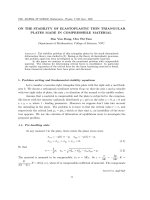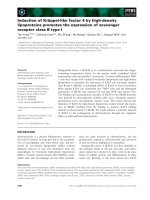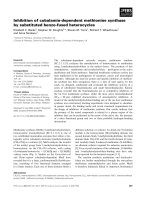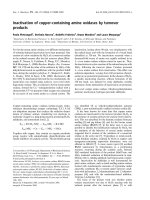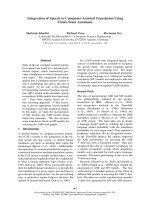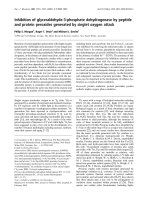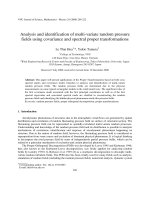Báo cáo "On the stability of the distribution function of the composed random variables by their index random variable " pdf
Bạn đang xem bản rút gọn của tài liệu. Xem và tải ngay bản đầy đủ của tài liệu tại đây (127.79 KB, 6 trang )
VNU Journal of Science, Mathematics - Physics 23 (2007) 70-74
On the stability of the distribution function of the composed
random variables by their index random variable
Nguyen Huu Bao
∗
Faculty of Infomation Technology, Water Resources University
175 Tay Son, Dong Da, Hanoi, Vietnam
Received 15 November 2006; received in revised form 2 August 2007
Abstract. Let us consider the composed random variable η =
ν
k=1
ξ
k
, where ξ
1
, ξ
2
,
are independent identically distributed random variables and ν is a positive value random,
independent of all ξ
k
.
In [1] and [2], we gave some the stabilities of the distribution function of η in the following
sense: the small changes in the distribution function of ξ
k
only lead to the small changes in
the distribution function of η.
In the paper, we investigate the distribution function of η when we have the small changes of
the distribution of ν.
1. Introduction
Let us consider the random variable (r.v):
η =
ν
k=1
ξ
k
(1)
where ξ
1
, ξ
2
, are independent identically distributed random variables with the distribution function
F (x), ν is a positive value r.v independent of all ξ
k
and ν has the distribution function A(x).
In [1] and [2], η is called to be the composed r.v and ν is called to be its index r.v. If Ψ(x) is
the distribution function of η with the characteristic function ψ(x) respecrively then (see [1] or [2])
ψ(x) = a[ϕ(t)] (2)
where a(z) is the generating function of ν and ϕ(t) is the characteristic function of ξ
k
.
In [1] and [2], we gave some the stabilities of Ψ(x) in the following sence: the small changes
in the distribution function F (x) only lead to the small changes in the distribution function Ψ(x).
In this paper, we shall investigate the stability of η’s distribution function when we have the
small change of the distribution of the index r.v ν.
∗
Tel.: 84-4-5634255.
E-mail:
70
Nguyen Huu Bao / VNU Journal of Science, Mathematics - Physics 23 (2007) 70-75 71
2. Stability theorem
Let us consider the r.v now:
η
1
=
ν
1
k=1
ξ
k
(3)
where ν
1
has the distribution function A
1
(x) with the generating function a
1
(z). Suppose ξ
k
have the
stable law with the characteristic function
ϕ(t) = exp{iµt −c|t|
α
[1 −eβ
t
|t|
ω(t; α)]} (4)
where c, µ, α, β are real number, c ≥ 0; |β| 1,
2 ≥ α ≥ α
1
> 1; ω(t; α) = tg
αt
2
. (5)
For every ε > 0 is given, such that
ε < (
π
3c
2
)
3
(6)
where c
2
= (c + c|β||tg
α
1
π
2
+ |µ|).
We have the following theorem:
Theorem 2.1 (Stability Theorem). Assume that
ρ(A; A
1
) = sup
x∈R
1
|A(x) −A
1
(x)| ε
µ
α
A
=
+∞
0
z
α
dA(z) < +∞; µ
α
A
1
=
+∞
0
z
α
dA
1
(z) < +∞, ∀α > 0. (7)
Then we have
ρ(Ψ, Ψ
1
) K
1
ε
1/6
where K
1
is a constant independent of ε, Ψ(x) and Ψ
1
(x) are the distribution function of η and η
1
respectively.
Lemma 2.1. Let a is a complex number, a = ρe
iθ
, such that |θ|
π
3
; 0 ρ 1. Then we have the
following estimation:
|a
t
− 1|
√
14|a −1|
(1 − |a −1|)
(for every t > 0) (8)
Proof. Since a = ρ(cos θ + i sin θ), it follows that a
t
= ρ
t
(cos tθ + i sintθ).
Hence
|a
t
−1|
2
= (ρ
t
cos tθ − 1)
2
+ (ρ
t
sin tθ)
2
, (9)
we also have
(ρ
t
cos tθ − 1) = (ρ
t
−1) cos tθ + (cos tθ − 1),
Notice that |1 −cos x| |x| for all x, thus
|ρ
t
cos tθ − 1| |ρ
t
− 1|+ |tθ|.
On the other hand, since |sin u| |u| for all u,
|a
t
− 1|
2
2|ρ
t
− 1|
2
+ 2t
2
θ
2
+ ρ
2t
t
2
θ
2
, (10)
72 Nguyen Huu Bao / VNU Journal of Science, Mathematics - Physics 23 (2007) 70-75
we can see
|a −1|
2
= (ρ cos θ −1 )
2
+ (ρ
2
sin
2
θ).
It follows that
|ρ sin θ| |a −1|. (11)
Furthermore,
||a| −1| |a −1| ⇒ |ρ −1| |a −1| ⇒ ρ ≥ 1 − |a − 1|.
From (11) we obtain
|sin θ|
|a −1|
ρ
|a − 1|
1 − |a − 1|
. (12)
Since |θ|
π
3
⇒ |sinθ| ≥
|θ|
2
, so that
|θ|
2|a − 1|
(1 −|a −1|)
. (13)
From (10) and (13), we have
|a
t
−1|
2
2|ρ
t
−1|
2
+
8t
2
|a −1|
2
(1 − |a −1|)
2
+ 4
ρ
2t
t
2
|a − 1|
2
(1 − |a −1|)
2
. (14)
For all t ≥ 0, the following inequality holds:
1 −ρ
t
t(1 − ρ)
ρ
. (15)
Using (11) and notice that |1 −ρ| = |1 − |a| | |a − 1|, we shall have
1 −ρ
t
t|a −1|
ρ
. (16)
Hence by (14) we get
|a
t
− 1|
2
14t
2
|a −1|
2
(1 −|a −1|)
2
.
Lemma 2.2. Under the notation in (2), let δ(ε) be sufficiently small postive number such that δ(ε) → 0
when ε → 0 and
|argϕ(t)|
π
3
∀t, |t| δ(ε).
Then
|ψ(t) − ψ
1
(t)| C|t| ∀t, |t| δ(ε)
where C is a constant independent of ε and ψ
1
(t) is the characteristic function with the distribution
function Ψ
1
(t) respectively.
Proof. We have
|ψ(t) − ψ
1
(t)| = |
+∞
0
|ϕ(t)|
z
d[A(z) − A
1
(z)]|
+∞
0
|ϕ
z
(t) − 1|d[A(z) + A
1
(z)]. (17)
Notice that, for all t ∈ R
1
|e
itx
−1| 3|sin(
tx
2
)|
3
2
|tx| < 2|tx|.
Hence, if we put
µ
F
=
+∞
−∞
|x|dF (x) < +∞; ϕ(t) =
+∞
−∞
e
itx
dF (x),
Nguyen Huu Bao / VNU Journal of Science, Mathematics - Physics 23 (2007) 70-75 73
then
|ϕ(t) −1|
|e
itx
− 1|dF < 2|t|µ
F
.
From lemma 2.1, (with a = ϕ(t); |t| δ(ε))
|ϕ(t) −1|
√
14z|ϕ(t) −1 |
(1 − |ϕ(t) − 1|)
. (18)
Because there exits moments (from (7)) and with t, |t| δ(ε) we can see |1 − ϕ(t)|
1
2
, therefore
|ψ(t) − ψ
1
(t)|
+∞
0
√
14z|ϕ(t) −1 |
(1 − |ϕ(t) − 1|)
d[A(z) + A
1
(z)] 4
√
14µ
F
(µ
A
+ µ
A
1
)|t| = C|t|
(do |ϕ(t) −1| µ
F
|t| ∀t)
where C is a constant independent of ε and µ
F
=
+∞
−∞
|x|dF (x) < ∞.
Proof of Theorem 2.1.
For every N > 0 and t ∈ R
1
, we have
|ψ(t) − ψ
1
(t)| = |
+∞
0
ϕ
z
(t)d[A(z) − A
1
(z)]|
|
N
0
ϕ
z
(t)d[A(z) − A
1
(z)]|+ |
+∞
N
ϕ
z
(t)d[A(z) − A
1
(z)]|
|[A(z) − A
1
(z)]|
N
0
| +
N
0
|A(z) − A
1
(z)||ϕ
z
(t)||ln ϕ(t)|dz +
+∞
N
d[A(z) + A
1
(z)]
= I
1
+ I
2
+ I
3
. (19)
First, it easy to see that
I
1
2ε. (20)
In order to estimate I
2
, notice that ϕ(t) has form (4) with the condition (5) so we have
|ln ϕ(t)| |µ||t|+ |t|
α
(c + c|β||tg
απ
2
|) |µ||t| + C
1
|t|
α
(21)
where C
1
= c + c|β||tg
απ
2
| c + c|β||tg
α
1
π
2
|.
If T = T (ε) is a positive number which will be chosen later (T (ε) → ∞ when ε → 0), we can see
that
|ln ϕ(t)| |µ|T + C
1
T
α
(C
1
+ |µ|)T
α
C
2
T
α
∀t, |t| T (ε)
where C
2
= c + c|β||tg
α
1
π
2
| + |µ|; (α ≥ α
1
> 1).
Then
I
2
ε
N
0
C
2
T
α
dz C
2
εT
α
N. (22)
Finally, with α from condition (5), we have
I
3
µ
α
A
+ µ
α
A
1
N
α
. (23)
By using (19), (20), (21), (23), we conclude that
|ψ(t) − ψ
1
(t)| 2ε + C
2
εT
α
N +
µ
α
A
+ µ
α
A
1
N
α
. (24)
74 Nguyen Huu Bao / VNU Journal of Science, Mathematics - Physics 23 (2007) 70-75
Choosing T = ε
−
1
3
α
and N = T = ε
−
1
3
α
, we can see that
C
2
εT
α
N C
2
ε
1−
1
3
−
1
3
= C
2
ε
1
3
,
(µ
α
A
+ µ
α
A
1
)N
−α
= (µ
α
A
+ µ
α
A
1
)ε
1
3
.
Thus
|ψ(t) − ψ
1
(t)| 2ε + C
2
ε
1
3
+ (µ
α
a
+ µ
α
A
1
)ε
1
3
= C
3
ε
1
3
(25)
for every t with |t| T = ε
−
1
3
α
and C
3
is a constant independent of ε.
For all δ(ε) > 0, we consider now
T
−T
|
ϕ(t) −ϕ
1
(t)
t
|dt =
δ(ε)
−δ(ε)
|
ϕ(t) −ϕ
1
(t)
t
|dt +
δ(ε)|t|T
|
ϕ(t) − ϕ
1
(t)
t
|dt.
Since
ln z = ln |z| + iarg(z) (0 argz 2π),
for all complex number z, letting z = ϕ(t), (|t| δ(ε))
|argϕ(t)| |ln ϕ(t)| C
2
δ(ε)
with δ(ε) = ε
1
3
, we shall get |argϕ(t)| C
2
ε
1
3
and from (6)
C
2
ε
1
3
π
3
⇒ |argϕ(t)|
π
3
for every t, |t| δε.
Hence, using lemma 2.2, we obtain:
δ(ε)
−δ(ε)
|
ϕ(t) − ϕ
1
(t)
t
|dt 2Cδ( ε) = 2Cε
1
3
. (26)
On the other hand, using (25), we get
δ(ε)|t|T
|
ϕ(t) − ϕ
1
(t)
t
|dt C
3
ε
1
3
T
δ(ε)
dt
t
= C
3
ε
1
3
ln
T
δ(ε)
= C
3
ε
1
3
ln(
1
ε
1 + α
3α
) C
4
ε
1
6
. (27)
From (26) and (27)
T
−T
|
ϕ(t) − ϕ
1
(t)
t
|dt 2Cε
1
3
+ C
4
ε
1
6
C
5
ε
1
6
where C
5
is constant independent of ε.
Indeed, by using Essen’s inequality (see [3]) we have
ρ(Ψ; Ψ
1
) C
5
ε
1
6
+ C
6
ε
1
4
K
1
ε
1
6
where K
1
is a constant independent of ε.
Nguyen Huu Bao / VNU Journal of Science, Mathematics - Physics 23 (2007) 70-75 75
Acknowledgements. This paper is based on the talk given at the Conference on Mathematics, Me-
chanics, and Informatics, Hanoi, 7/10/2006, on the occasion of 50th Anniversary of Department of
Mathematics, Mechanics and Informatics, Vietnam National University.
References
[1] Tran Kim Thanh, On the characterization of the distribution of the composed random variables and their stabilities
Dotor thesis, Hanoi 2000.
[2] Tran Kim Thanh, Nguyen Huu Bao, On the geometric composed variables and the estimate of the stable degree of the
Renyi’s characteristic theorem, Acta Mathemaica Vietnamica 21 (1996) 269.
[3] C. G. Essen, Fourier analysis of distribution functions, Acta Math. 77 (1945) 125.
